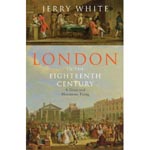Book review: London in the 18th Century
Fascinating insights into the life of Georgian London are to be found in this latest history book, finds Dan Cruickshank


To order any of the books reviewed or any other book in print, at
discount prices* and with free p&p to UK addresses, telephone the Country Life Bookshop on Bookshop 0843 060 0023. Or send a cheque/postal order to the Country Life Bookshop, PO Box 60, Helston TR13 0TP * See individual reviews for CL Bookshop price
History London in the Eighteenth Century Jerry White (Bodley Head, £25, *£21.25)
This book offers informed and fascinating insights into life in Georgian London. The vast amount of material it contains is marshalled in a logical and satisfactory manner, not only to make sense of a complex story, but also to tell a good tale. The author moves skilfully from the general to the particular, making general points by reference to the lives of a large and socially diverse range of inhabitants. Some are well-known figures, but many are ordinary people whose experiences are emblematic of the age. In this way, the book chronicles the changing moods, fashions and evolving, all-embracing ideas of that era in a most intimate manner.
The text is divided into five principal parts, each of which represents a theme-the city, people, work, culture, power. Each part is split into sections, most of which are organised around key personalities. For example, ‘City' deals with the nature of the physical growth of Georgian London, with a section focusing on the major early-18th-century architect James Gibbs and a sub-sequent one on the late-18th-century architect Robert Adam. Other figures highlighted include Samuel Johnson, Teresa Cornelys who kept a major establish-ment of entertainment and receptions in Soho Square-Henry Fielding and John Wilkes.
Jerry White presents his overview of the creation and life of Georgian London with unpre-cedented clarity, but there are still a few mysteries to be resolved. One relates to the low-life of the ‘the great and monstrous city', as Daniel Defoe characterised London in the early 1720s. The book reflects on the conundrum of the size, extent and broader cultural and economic influences of the city's huge sex industry.
Contemporary observers speculated that there were between 40,000 and 50,000 prostitutes in Georgian London, suggesting that about one women in six of the sexually active population was involved. These figures were offered by the French visitor César de Saussure in the 1720s, the German Johann von Archen-holz in the 1780s and the police magistrate Patrick Colquhoun in the 1790s. Why was the unlikely number of 50,000 accepted, if it wasn't to a degree based on observation and fact? Was it just a fanciful inflation derived from tradition, habit or ignorance?
Exquisite houses, the beauty of Nature, and how to get the most from your life, straight to your inbox.
Prof White favours the lower figure of 2,000 to 3,000 that has been offered by a number of current historians and, in the 1750s, by Henry Fielding's associate Saunders Welch, a campaigning social reformer and High Constable of Holborn. But if Welch's total of harlots was relatively low, he was outspoken in his alarm at their ubiquity: ‘Prostitutes swarm in the streets to such a degree... that a stranger would think... the whole town was one general stew.'
What are we to think? It would seem the final paragraph on this aspect of the city is still to be written. But in all other respects, this book offers the last, definitive word on Georgian London. It's a tremendous work-well researched, well written, solid and reliable, mastering a complex subject in an authoritative account that is a pleasure to read.
* Subscribe to Country Life and save over £50 a year
Country Life is unlike any other magazine: the only glossy weekly on the newsstand and the only magazine that has been guest-edited by His Majesty The King not once, but twice. It is a celebration of modern rural life and all its diverse joys and pleasures — that was first published in Queen Victoria's Diamond Jubilee year. Our eclectic mixture of witty and informative content — from the most up-to-date property news and commentary and a coveted glimpse inside some of the UK's best houses and gardens, to gardening, the arts and interior design, written by experts in their field — still cannot be found in print or online, anywhere else.
